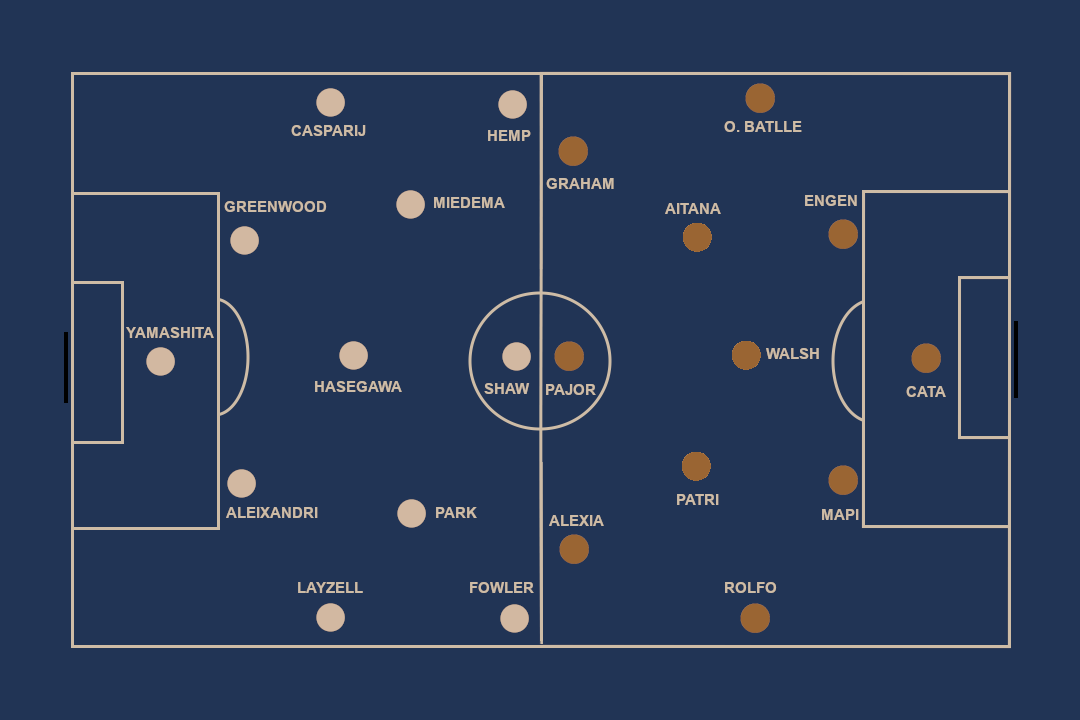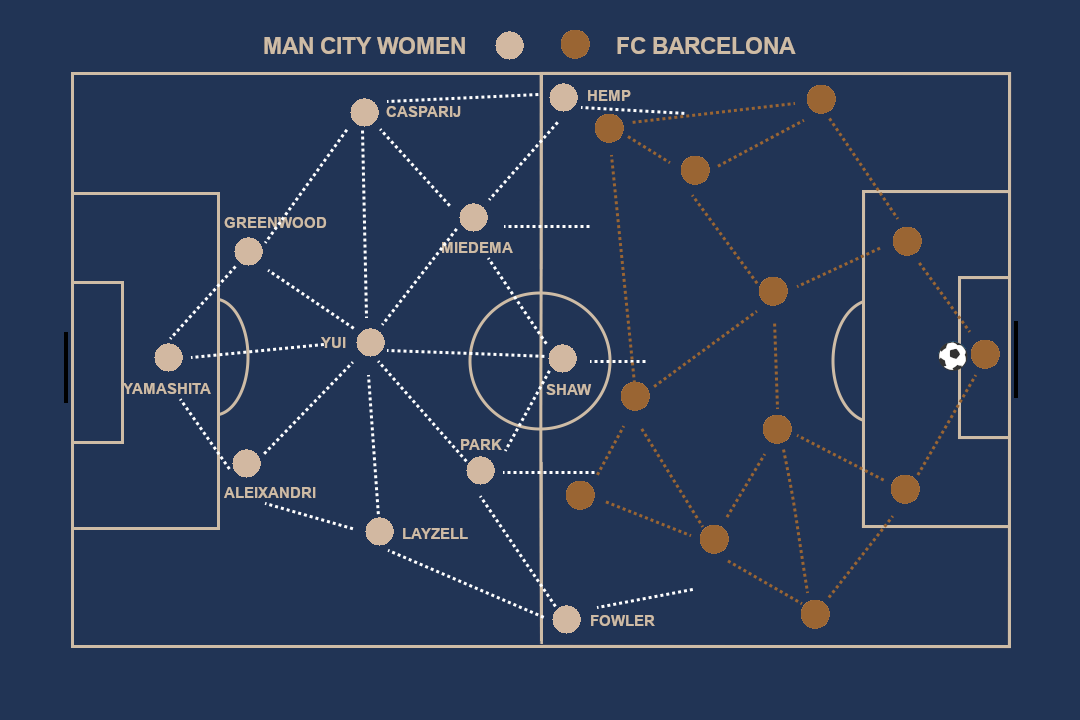
Barça Femení were handed their first loss this season during a tricky trip to Manchester. What went wrong for Barça? More accurately, how did City do it? Here is a short look into it.
The Line-ups.
Barça started out with a supposed 4-3-3. Due to player profiles, Rolfö was designed to push up high and Alexia would drop to create a midfield overload. Making it a 3-2-4-1. City started a 4-3-3, with several new names in the line-up. Notably, Layzell, Fowler, and an unexpected shift to the left for Casparij.
And guess what, City came to play. From kick-off, they didn’t let Barça have enough time on the ball to set-up plays. They managed to protect most of their key playmakers on the day. Hasegawa, Laia Aleixandri (occasionally) and Layzell who at times would drop into the midfield to distract attention from Yui. They did this by spreading wide the pitch. They kept Barça’s press far away from her (Yui).
Of course that was made easier by the fact that Pajor was virtually the only player Barça had upfront. Rendering it a 4 v 1 advantage for City. Still, she pressed relentlessly. Almost giving Barça the lead at one moment.

Build-Up Tactics.
In Build-up, City used a 4-1-4-1 with the goalkeeper as an instrumental part of it. Counting the goalie, it becomes more like 5-1-4-1. The 4-1-4-1 was very intense and had its vulnerabilities but the advantages were numerous. The kind of tactics you would normally associate with Lyon (In their previous encounters with Barça).
Their pattern would change constantly. Sometimes, back to their base 4-3-3, with Bunny Shaw dropping, and Fullbacks (Layzell and Casparij) pushing up high. This would leave Hasegawa vulnerable to press but Barça didn’t have enough bodies upfront to pull it off. It also meant Barça were at a disadvantage because pressing 4 (5) players with one forward (Pajor), well, that’s bad math in the long run. Physically draining and tactically unfeasible.

Attack and Transitions.
While Barca’s attacks were far and few in between, City’s were fast and relentless, especially the first 30. They attacked in a 2-3-5, overwhelming Barca’s defense. They also did that by expanding the field of play, fullbacks high, wingers (Hemp) wide. Hemp was the main outlet. In addition, City won their duels. With Park and Miedema arriving in the box a lot through the middle, as expected.
City seemed to have overloads everywhere in various types of transitions. Offensive and defensive. Lots of positional superiority at various spots on the field.
They did well to keep Barça’s main progression experts (Mapi, Rolfö and Graham) in the defense all of the first half using that suffocating press of 5. Man-marking. They kept Barça’s flanks quiet. Ona was pinned, Graham was pinned and so was Rolfö. Barça didn’t have a natural LW up the pitch. Alexia (expected to take the role) more often than not, would drop in the midfield (Her natural role). At one point, there was more than 5 players advancing towards Mapi Leon.

Why were Barca’s up the pitch advances limited?
Pere Romeu didn’t start a natural winger upfront. Instead, all the wing services fell to Rolfo. Who was heavily marked and frankly couldn’t do much. This meant the wing Barça uses to move up the pitch was futile on the day. As the game matured, City’s right wing took more and more advantage of this as well.
Another important aspect of the match was physical preparedness. And surprisingly, Barça were ill prepared (or looked like it).
Barça’s narrow structure on the pitch meant a lot of errors as well. Midfielders too close together produced a lot of turnovers, instead of the intended ‘flow’. Jess Park, Bunny Shaw and Miedema were almost always the immediate beneficiaries of those turnovers.
Defensively, Barça did well, considering they were on the defense a lot in the first 30 minutes.
A better but Inadequate Second Half.
Initially, Barça did not make any changes to the line up or the tactics. Just a little more accuracy in the passing but no fruits came of it. Much like the first half, Barça intended to set up in a 3-2-4-1, with Rolfö high up, and Alexia dropping into midfield. Therefore turning it into more like a 2-4-2-2 and at times, 2-4-3-1. City were more reserved but still ready to pounce on any turnovers and again attack in the 2-3-5. Barça saw all their attempts at goal saved.
The substitutions came late, and all wrong. Claudia Pina improved the offensive output but taking Ingrid Engen out meant creating another defensive problem. City’s second goal would come in from their Right flank (Barça’s left) thanks to a ball in behind that found Shaw onside. One can’t help but think that moving Patri back to defense was a mistake. Probably resulted to the second goal.
Conclusions.
All in all, Barça’s approach was all wrong on the day. City kept them on the defense, physically ‘bullied’ them and ultimately overwhelmed them with chances. The press from Manchester City proved to be a new pace.
As Blaugranagram’s Hans Mickey says, Barça can’t get away with jogging and passing as much against these kinds of tactics. And every year we get reminded of this the first time they face a German or an English team. The lesson just never seems to stick.





More articles
“I never imagined that Raphinha could reach Barcelona”
Jandro Orellana: “I hope Barcelona wins La Liga”
All Roads Lead To Lisbon